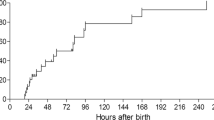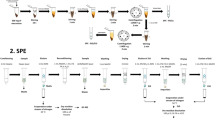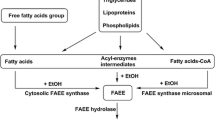Abstract
Ethanol is a legal and widely available substance. There are health and social consequences associated with its abuse. One of the most important problems is related to alcohol consumption during pregnancy. In fact, prenatal ethanol exposure can be associated with fetal alcohol spectrum disorder (FASD), a term used to describe a wide range of potentially lifelong effects that include physical, mental, behavioral, and learning disabilities. Fatty acid ethyl esters (FAEEs), which are non-oxidative metabolites of ethanol, are currently used as biomarkers of direct ethanol consumption in different matrices, including hair, blood, skin surface, and meconium. Analysis of these compounds in meconium reveals exposure to alcohol during the second and third trimesters of pregnancy. An important finding for evaluation of gestational ethanol exposure is the fact that FAEEs do not cross the placenta. Because they accumulate in the fetal gut from approximately the 20th week of gestation until birth, this provides a wide window of detection of chronic exposure to alcohol. The sum of the concentrations of all the FAEEs, with a cutoff of 2 nmol g−1 or 600 ng g−1 meconium, has been recommended as evidence of maternal alcohol use. We introduce a novel technique to quantify ethyl myristate, ethyl palmitate, ethyl stearate, and their deuterated analogues (as internal standards, IS) in meconium using microwave-assisted extraction (MAE) coupled with gas chromatography–mass spectrometry (GC–MS). Limits of detection and quantification were 50 and 100 ng g−1 for all analytes except ethyl stearate (LOD 100 ng g−1 and LOQ 500 ng g−1). Calibration curves were linear from the LOQ to 5000 ng g−1. The validated method was applied to the analysis of 81 meconium samples.






Similar content being viewed by others
References
Bearer CF, Jacobson JL, Jacobson SW, Barr D, Croxford J, Molteno CD, Viljoen DL, Marais AS, Chiodo LM, Cwik AS (2003) Validation of a new biomarker of fetal exposure to alcohol. J Pediatr 143:463–469
Roehsig M, Mendes de Louzada D, Moura S, Albuquerque EM, Yonamine M (2010) Determination of eight fatty acid ethyl esters in meconium samples by headspace solid phase microextraction and gas chromatography–mass spectrometry. J Sep Sci 33:2115–2122
González-Illán F, Ojeda G, Díaz Liz M, Rosario O (2011) Detection of fatty acid ethyl esters in skin surface lipids as biomarkers of etanol consumption in alcoholics, social drinkers, light drinkers and teetotalers using a methodology base don microwave-assisted extraction followed by solid-phase microextraction as gas chromatography–mass spectrometry. J Anal Toxicol 35:232–237
Joya X, Friguls B (2012). Determination of maternal-fetal biomarkers of prenatal exposure to ethanol: A review. Journal of Pharmaceutical and Biomedical Analysis. In press
Bakdash A, Burger P, Goecke T, Fasching P, Reulbach U, Bleich S, Hastedt M, Rothe M, Beckmann M, Pragst F, Kornhuber J (2010) Quantification of fatty acid ethyl esters (FAEE) and ethyl glucuronide (EtG) in meconium from newborns for detection of alcohol abuse in a maternal health evaluation study. Anal Bioanal Chem 396:2469–2477
Pichini S, Marchei E, Vagnarelli F, Tarani L, Raimondi F, Maffucci R, Sacher B, Bisceglia M, Rapisardi G, Elicio MR, Biban P, Zuccaro P, Pacifici R, Pierantozzi A, Morini L (2011) Assessment of prenatal exposure to ethanol by meconium analysis: Results of an Italian multicenter study. Alcohol Clin Exp Res 36(3):417–424
Shor S, Nulman I, Kulaga V, Koren G (2010) Heavy in utero ethanol exposure is associated with the use of other drugs of abuse in a high-risk population. Alcohol 44:623–627
Goh Y, Hutson J, Lum L, Roukema H, Gareri J, Lynn H, Koren G (2010) Rates of fetal alcohol exposure among newborns in a high-risk obstetric unit. Alcohol 44:629–634
Gareri J, Lynn H, Handley M, Rao C, Koren G (2008) Prevalence of fetal ethanol exposure in a regional population based sample by meconium analysis of fatty acid ethyl esters. Ther Drug Monit 30(2):239–245
Chan D, Bar-Oz B, Pellerin B, Paciorek C, Klein J, Kapur B, Farine D, Koren G (2003) Population baseline of meconium fatty acid ethyl esters among infants of nondrinking women in Jerusalem and Toronto. Ther Drug Monit 25:271–278
Hutson J, Rao C, Fulga N, Aleksa K, Koren G (2011) An improved method for rapidly quantifying fatty acid ethyl esters in meconium suitable for prenatal alcohol screening. Alcohol 45:193–199
Hutson JR, Aleksa K, Pragst F, Koren G (2009) Detection and quantification of fatty acid ethyl esters in meconium by headspace solid phase microextraction and gas chromatography–mass spectrometry. J Chromatogr B 877:8–12
García-Algar O, Kulaga V, Gareri J, Koren G, Vall O, Zuccaro P, Pacifici R, Pichini S (2008) Alarming prevalence of fetal alcohol exposure in a Mediterranean city. Ther Drug Monit 30(2):249–254
Pichini S, Pellegrini M, Gareri J, Koren G, García-Algar O, Vall O, Vagnarelli F, Zuccaro P, Marchei E (2008) Liquid chromatography–tandem mass spectrometry for fatty acid ethyl esters in meconium: Assessment of prenatal exposure to alcohol in two European cohorts. J Pharm Biomed Anal 48:927–933
Kwak H, Kang Y, Han K, Moon J, Chung Y, Choi J, Han J, Kim M, Armenta E, Ocampo A (2010) Quantitation of fatty acid ethyl esters in human meconium by an improved liquid chromatography/tandem mass spectrometry. J Chrom B 878:1871–1874
Moore C, Jones J, Lewis D, Buchi K (2003) Prevalence of fatty acid ethyl esters in meconium specimens. Clin Chem 49(1):133–136
Álvarez I, Bermejo AM, Tabernero MJ, Fernández P, Cabarcos P, López P (2009) Microwave-assisted extraction: a simpler and faster method for the determination of ethyl glucuronide in hair by gas chromatography–mass spectrometry. Anal Bioanal Chem 393:1345–1350
Cabarcos P, Álvarez I, Bermejo AM, Tabernero MJ, López P, Fernández P (2009) Analysis of fatty acid ethyl esters in hair by headspace solid phase microextraction (HS-SPME) and gas chromatography–mass spectrometry (GC–MS). Anal Lett 42:2962–2977
Pragst F, Auwärter V, Sporkert F, Spiegel K (2001) Analysis of fatty acid ethyl esters in hair as possible markers of chronically elevated alcohol consumption by headspace solid-phase microextraction (HS-SPME) and gas chromatography–mass spectrometry (GC–MS). For Sci Int 121:76–88
Mandal V, Mohan Y, Hemalatha S (2007) Micrawave assisted extraction- An innovative and promising extraction tool for medical plant research. Phcog Rev 1(1):7–18
Fernández P, Vázquez C, Lorenzo RA, Carro AM, Álvarez I, Cabarcos P (2010) Experimental design for optimization of microwave-assisted extraction of benzodiazepines in human plasma. Anal Bioanal Chem 397:677–685
Álvarez I, Bermejo AM, Cid P, Tabernero MJ, Fernández P, López P (2008) Microwave-assisted extraction for the determination of ethyl glucuronide in urine by gas chromatography–mass spectrometry. J Appl Toxicol 28:773–778
Food and Drug Administration. 2001. U.S. Department of Health and Human Services, Guidance for Industry, Bioanalytical Method Validation. FDA [Available on line at URL: http://www.fda.gov/downloads/Drugs/GuidanceComplianceRegulatoryInformation/Guidances/ucm070107.pdf] (Accessed January 2012)
Bernhardt TG, Cannistraro PA, Bird DA, Doyle KM, Laposata M (1996) Purification of fatty acid ethyl esters by solid phase extraction and high performance liquid chromatography. J Chromatogr B Biomed Appl 675:189–196
Gareri J, Appenzeller B, Walasek P (2011) Impact of hair-care products on FAEE hair concentrations in substance abuse monitoring. Anal Bioanal Chem 400:183–188
Suesse S, Pragst F, Mieczkowski T, Selavka CM, Elian A, Sachs H, Hastedt M, Rothe M, Campbell J (2011). Practical experiences in application of hair fatty acid ethyl esters and ethyl glucuronide for detection of chronic alcohol abuse in forensic cases. Forensic Sci Int. In press
Pragst F, Rothe M, Moench B, Hastedt M, Herre S, Simmert D (2010) Combined use of fatty acid ethyl esters and ethyl glucuronide in hair for diagnosis of alcohol abuse: Interpretation and advantages. For Sci Int 196:101–110
Albermann M, Musshoff F, Madea B (2010) Comparison of ethyl glucuronide (EtG) and fatty acid ethyl esters (FAEEs) concentrations in hair for testing abstinence. Anal Bioanal Chem 400(1):175–181
Burd L, Hofer R (2008) Biomarkers for detection of prenatal alcohol exposure: A critical review of fatty acid ethyl esters in meconium. Birth Defect Res (Part A) 82:487–493
Author information
Authors and Affiliations
Corresponding author
Electronic supplementary material
Below is the link to the electronic supplementary material.
ESM 1
(PDF 972 kb)
Rights and permissions
About this article
Cite this article
Cabarcos, P., Tabernero, M.J., Álvarez, I. et al. A new method for quantifying prenatal exposure to ethanol by microwave-assisted extraction (MAE) of meconium followed by gas chromatography–mass spectrometry (GC–MS). Anal Bioanal Chem 404, 147–155 (2012). https://doi.org/10.1007/s00216-012-6108-2
Received:
Revised:
Accepted:
Published:
Issue Date:
DOI: https://doi.org/10.1007/s00216-012-6108-2




